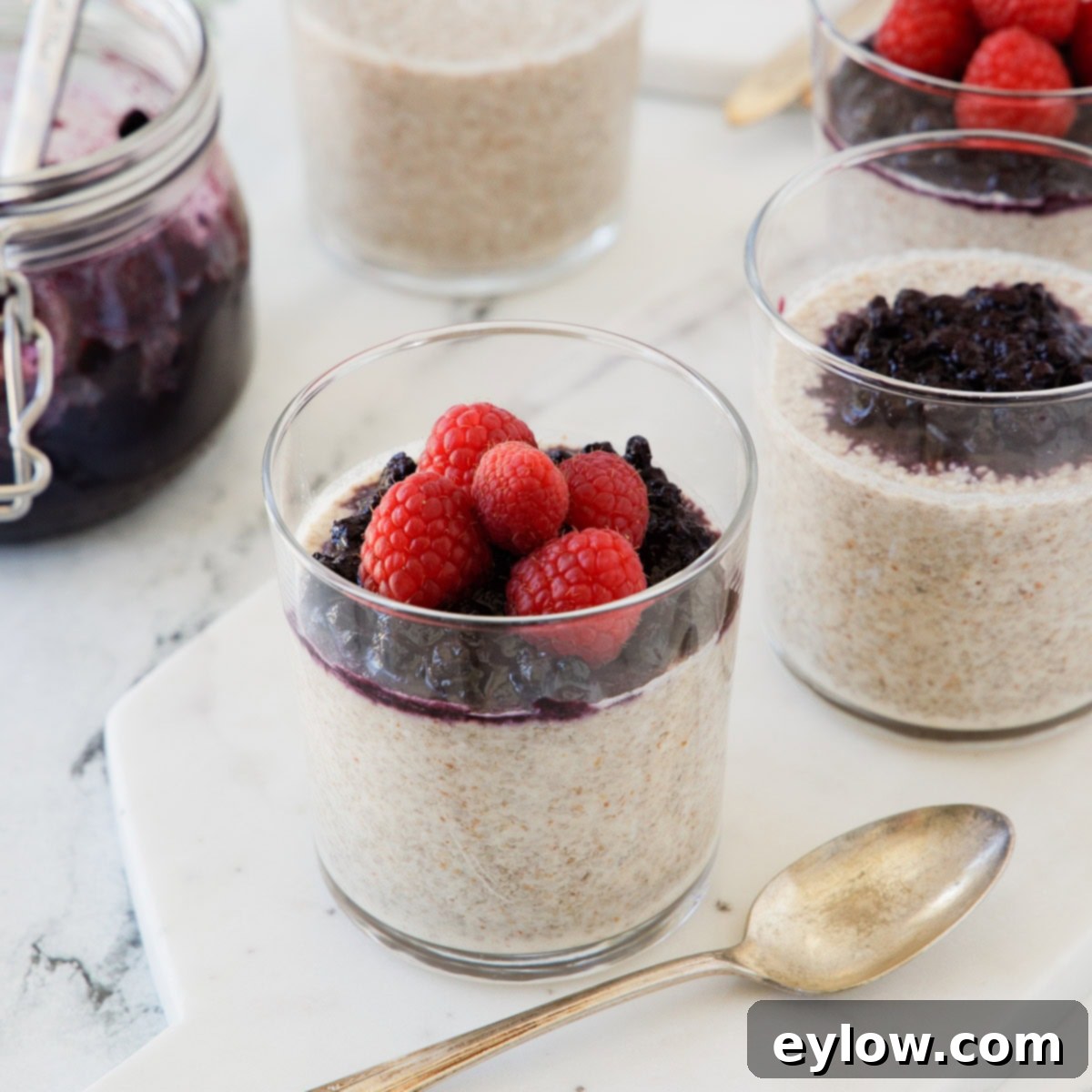Creamy Coconut Milk Chia Pudding: The Ultimate Healthy & Easy Make-Ahead Breakfast
Imagine a breakfast that feels like a decadent dessert but fuels your body with essential nutrients, keeping you full and energized for hours. This is precisely what you get with our incredibly versatile and utterly delicious chia seed and coconut milk pudding. It’s not just a simple, make-ahead meal; it’s a game-changer for busy mornings, offering a perfect blend of creaminess, satisfaction, and wholesome goodness. Whether you’re aiming for a high-protein start, need a dairy-free or vegan option, or simply crave something that tastes like a treat, this recipe seamlessly adapts to your lifestyle and palate.

My journey to crafting the perfect coconut chia pudding began during my travels, where I encountered truly exceptional versions. One memorable experience was at a luxurious Las Vegas buffet, and another more recently at a charming lodge near Glacier National Park. Both experiences were powerful reminders of how incredibly delicious and convenient this breakfast option can be, especially when you need something nourishing and satisfying. Inspired, I returned home determined to recreate that creamy indulgence, focusing on wholesome ingredients. My experiments led me to use full-fat canned coconut milk for unparalleled richness, incorporate protein for sustained satiety, and add just a touch of natural sweetener. The outcome? A consistently delightful breakfast that’s not only easy to customize but also ideal for meal prepping, ensuring a quick and healthy grab-and-go option every morning.
Why You’ll Love This Creamy Coconut Chia Pudding
This recipe isn’t just another breakfast idea; it’s a revelation. Here’s why this coconut milk chia pudding will become a staple in your kitchen:
- Unbelievably Creamy & Satisfying: Crafted with decadent full-fat coconut milk, this chia pudding offers a luxurious, rich texture that truly feels indulgent. It’s naturally gluten-free and dairy-free, making it a fantastic choice for a wide array of dietary preferences and lifestyles, including vegan and paleo. The healthy fats from the coconut milk and chia seeds contribute to a feeling of deep satisfaction, preventing those mid-morning hunger pangs.
- Infinitely Customizable: The beauty of this recipe lies in its adaptability. It’s a blank canvas ready for your creative touch. Whether you’re in the mood for vibrant fresh berries, a swirl of your favorite nut butter, a warming dash of cinnamon, or an extra boost of protein powder, the possibilities are endless. This allows you to tailor each serving to your specific nutritional needs, flavor cravings, or what’s in season.
- Effortless Make-Ahead Meal Prep: Say goodbye to stressful mornings! This pudding is designed for convenience. While a blender makes the process incredibly quick and ensures a super smooth consistency, you can easily whisk it by hand. Once mixed, simply portion it into individual containers, chill overnight, and you’re all set. Prepare a batch on Sunday evening, and you’ll have delicious, nutritious breakfasts ready to enjoy throughout the entire week, saving you valuable time and effort.
If you’re looking for other fantastic ways to incorporate chia seeds into your diet, be sure to try our high protein overnight oats with chia seeds for another nourishing and convenient breakfast option.
Key Ingredients for the Perfect Coconut Chia Pudding
Creating this delightful chia pudding requires just a few simple, high-quality ingredients. Choosing the right components will ensure the best flavor and texture:
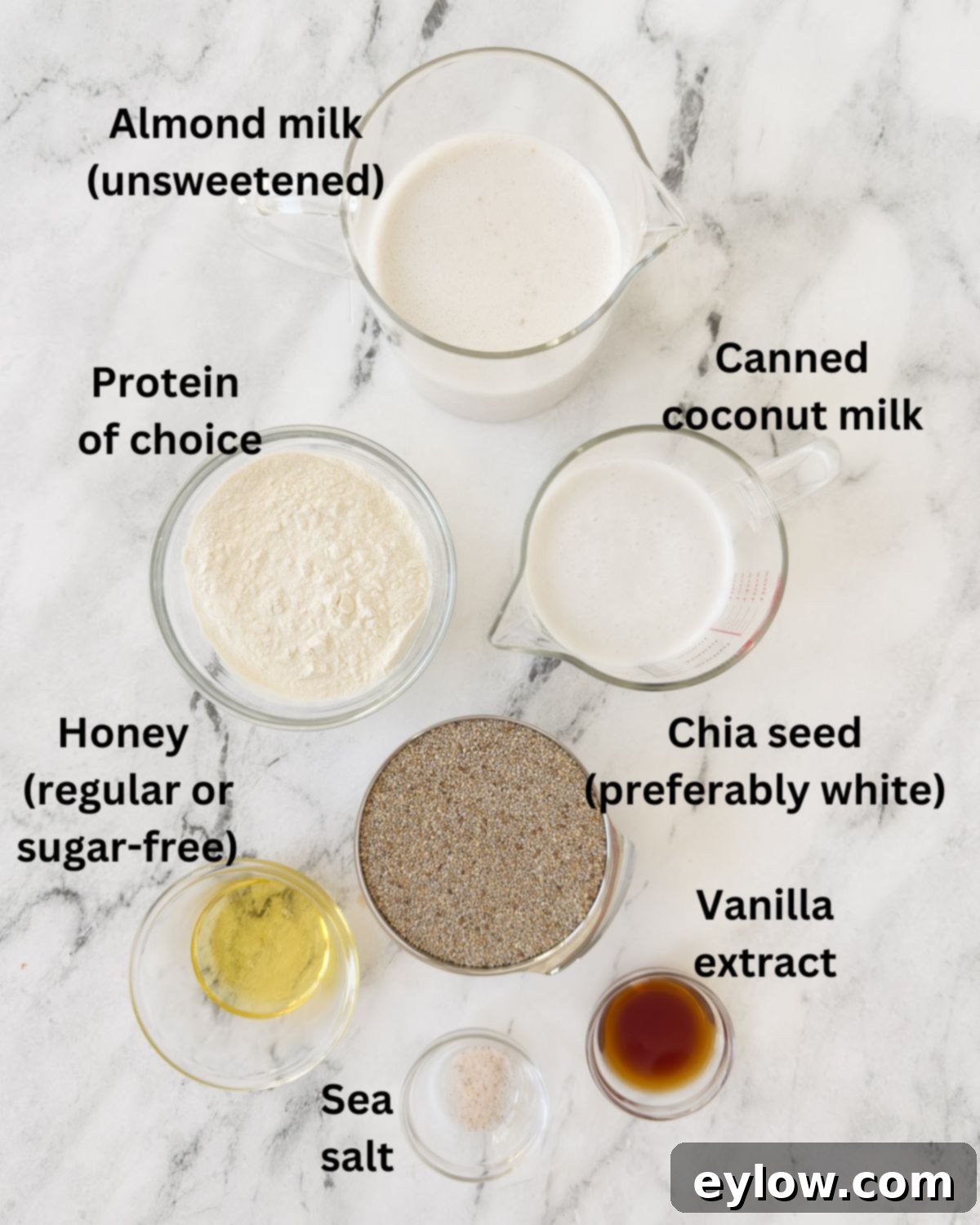
- Full-Fat Canned Coconut Milk: This is the secret to achieving that incredibly rich and creamy texture. Full-fat coconut milk provides a luxurious mouthfeel and a subtle tropical flavor that elevates the pudding. While light coconut milk can be used for a lower-calorie option, be aware that it will result in a thinner, less satisfying consistency. Look for brands with minimal additives for the purest flavor.
- Unsweetened Almond Milk: I often use my homemade almond milk, which tends to be thicker because it’s unstrained, adding an extra layer of richness. If you’re using store-bought almond milk, which works perfectly fine, make sure to opt for an unsweetened variety. This gives you full control over the sweetness level of your pudding and avoids unnecessary added sugars. Always check labels for any unwanted additives.
- Chia Seeds: These tiny powerhouses are the star of the show. They absorb liquid and expand, creating the pudding-like consistency while delivering an impressive amount of fiber, protein, and Omega-3 fatty acids. I personally prefer white chia seeds for their aesthetic appeal – they create a lighter, more visually appealing pudding. However, black chia seeds are nutritionally identical and will work just as effectively.
- Pure Vanilla Extract: A splash of high-quality pure vanilla extract is crucial for enhancing the overall flavor profile. It adds a warm, inviting aroma and a subtle sweetness that complements the coconut and other ingredients beautifully.
- Sweetener of Choice: This recipe is incredibly flexible when it comes to sweetening. Choose an option that best fits your dietary preferences:
- Natural Sweeteners: Maple syrup or honey offer natural sweetness with distinct flavor notes.
- Sugar-Free Alternatives: For those managing sugar intake, options like monk fruit maple syrup, monk fruit honey, or a plain monk fruit blend are excellent choices. Start with a smaller amount and adjust to your desired sweetness.
- Protein Powder (Optional but Recommended): For a significant boost in satiety and nutritional value, I highly recommend stirring in about half a scoop of your favorite protein powder. I typically use whey protein, but plant-based protein powders (like pea or rice protein) or collagen peptides are also excellent options. Adding protein helps balance your macros, keeps you feeling fuller for longer, and provides a robust start to your day.
- Pinch of Sea Salt: A tiny pinch of sea salt might seem counterintuitive in a sweet dish, but it’s a flavor enhancer. It helps to bring out the natural sweetness and depth of all the other ingredients, creating a more balanced and complex taste.
Specific measurements for each ingredient, along with detailed nutritional information, can be found in the comprehensive recipe card below.
Chef’s Note: Consistency is Key! The final thickness of your chia pudding can vary slightly depending on the specific types of milk you use. Canned coconut milk, for example, comes in different viscosities – some brands may be thicker due to added guar gum, while others are more fluid. Similarly, store-bought almond milk is often strained and thinner than a homemade, unstrained version. If your pudding doesn’t set as thick as you prefer after chilling, simply whisk in an additional tablespoon of chia seeds and let it chill for a few more hours or overnight. This extra time allows the seeds to fully absorb the liquid, ensuring a perfectly creamy and set pudding.
For another delicious and refreshing treat featuring coconut, consider making this creamy mango banana smoothie.
Endless Substitutions and Flavor Variations
While I haven’t explored every single combination imaginable (there are truly countless possibilities!), the fun part is experimenting to discover your own perfect blend. Make this chia and coconut pudding uniquely yours and uncover your favorite flavor twists!
This chia pudding recipe is designed to be incredibly flexible, allowing you to adapt it to your taste, dietary needs, and whatever ingredients you have on hand. Here are some fantastic ways to customize your creation:
- Diverse Milk Options: While full-fat canned coconut milk is highly recommended for its unmatched creaminess, feel free to swap the almond milk for other dairy-free alternatives. Oat milk provides a naturally sweet and creamy, nut-free base, while cashew milk adds a rich, buttery texture. Flax milk and hemp milk are also excellent choices, offering their own unique nutritional profiles. Remember to always choose unsweetened varieties to maintain control over the sugar content.
- Creative Toppings Galore: This is where you can truly let your imagination run wild! The right toppings can transform your pudding into a gourmet experience.
- Fresh Fruit: Diced mango, vibrant fresh berries (strawberries, blueberries, raspberries), perfectly sliced banana, or any chopped seasonal fruit add natural sweetness and a burst of freshness. My personal favorite, and what you see in many of the photos, is a dollop of homemade blueberry compote – it’s naturally sweet and packed with antioxidants.
- Added Texture & Flavor: For extra crunch and flavor, consider shredded coconut (toasted or raw), cacao nibs for a hint of chocolate, or chopped nuts like almonds, walnuts, or pecans. A sprinkle of granola can also add a delightful crunch.
- Dynamic Flavor Boosters: Easily change the entire profile of your pudding with these simple additions:
- Warm Spices: Stir in a pinch of cinnamon, cardamom, or ground ginger for a comforting, aromatic touch.
- Chocolate & Coffee: For a mocha-inspired treat, add a teaspoon of cocoa powder or espresso powder.
- Citrus Zest: A little lemon or orange zest can add a bright, zesty note.
- Tailored Sweetener Choices: The world of sweeteners offers many possibilities. Besides maple syrup and honey, you can also use date syrup, agave nectar, or various sugar-free options such as stevia, monk fruit, or allulose. Always start with a smaller amount, taste, and then adjust to your preferred level of sweetness.
- Boosted Protein Options: Beyond whey protein, collagen peptides are an excellent unflavored option that blends seamlessly, supporting skin and joint health. Pea protein or other plant-based protein powders are perfect for vegan diets. Choose a naturally flavored or unflavored powder to complement your pudding without overpowering its taste, aligning with your morning nutritional goals.
Chef’s Note: Adjusting Consistency & Homemade Milk Advantage: If you find your chia and coconut pudding is not as thick as you’d like after chilling, don’t fret! Simply stir in an additional tablespoon of chia seeds and allow it to rest for a bit longer in the refrigerator. You can always adjust the ratio for your next batch. Also, for an incredibly creamy and nutritious base, I highly recommend trying to make homemade almond milk. It’s surprisingly quick, easy, and makes a noticeable difference in the overall richness and texture of the pudding compared to many store-bought varieties. It’s my go-to choice for a reason!
How to Make Creamy Coconut Milk Chia Pudding
Making this delicious chia pudding is incredibly straightforward, whether you choose to use a blender for a super smooth consistency or simply whisk it by hand. The key is allowing enough time for the chia seeds to properly hydrate and thicken. Here’s a step-by-step guide:

- Combine Milks and Protein: Begin by adding both the unsweetened almond milk and the full-fat canned coconut milk to your blender container. If you’re including protein powder for an extra nutritional boost, add it now. Blend on a low setting until the mixture is completely smooth and any protein powder is fully dissolved, ensuring no clumps remain. This step helps create a uniform liquid base.
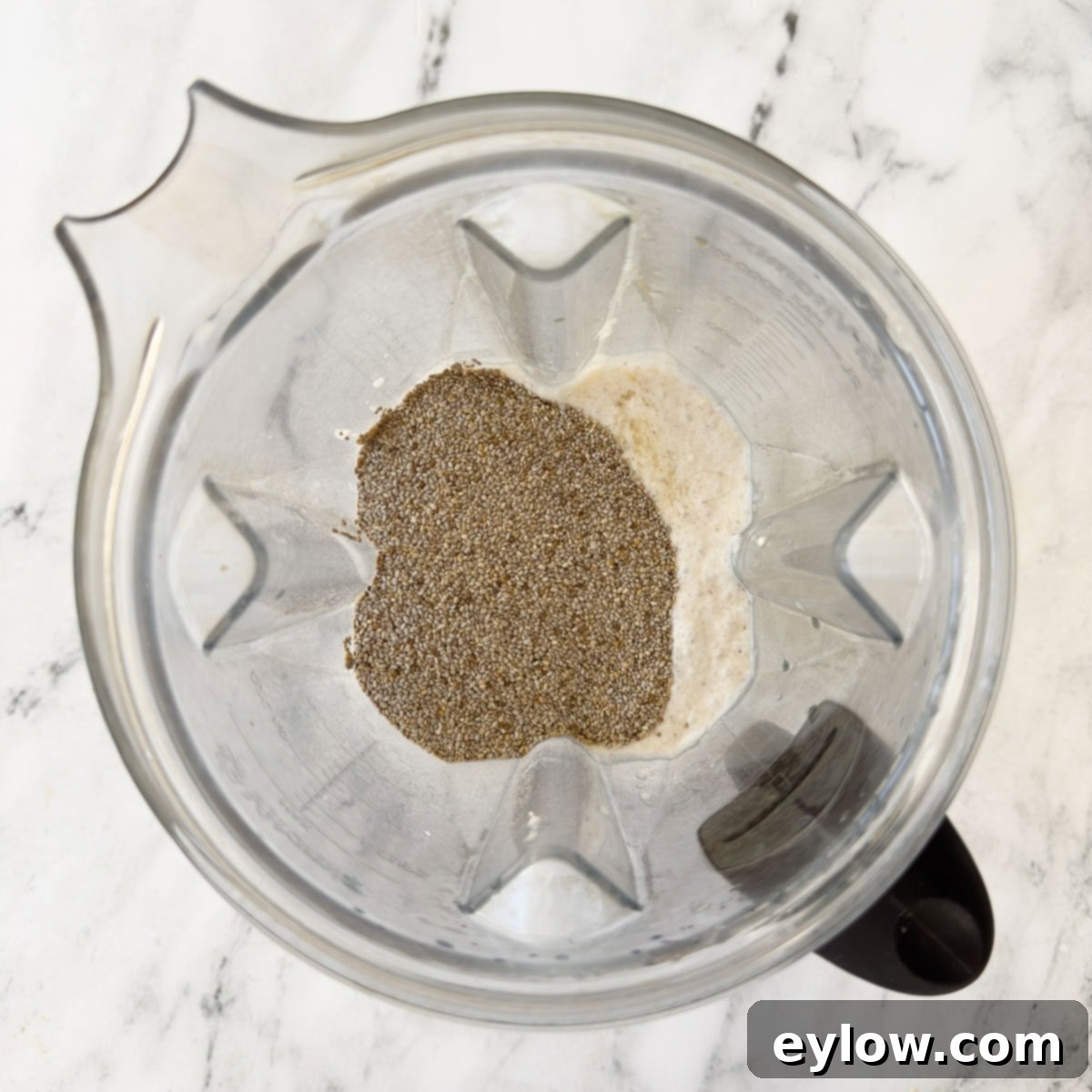
- Add Chia Seeds and Flavorings: Next, add the chia seeds, your chosen sweetener (maple syrup, honey, or a sugar-free alternative), pure vanilla extract, and a small pinch of sea salt to the blender. Blend again briefly on low speed, just until all the ingredients are well mixed. Avoid over-blending at this stage, as the goal is simply to incorporate the chia seeds evenly into the liquid.
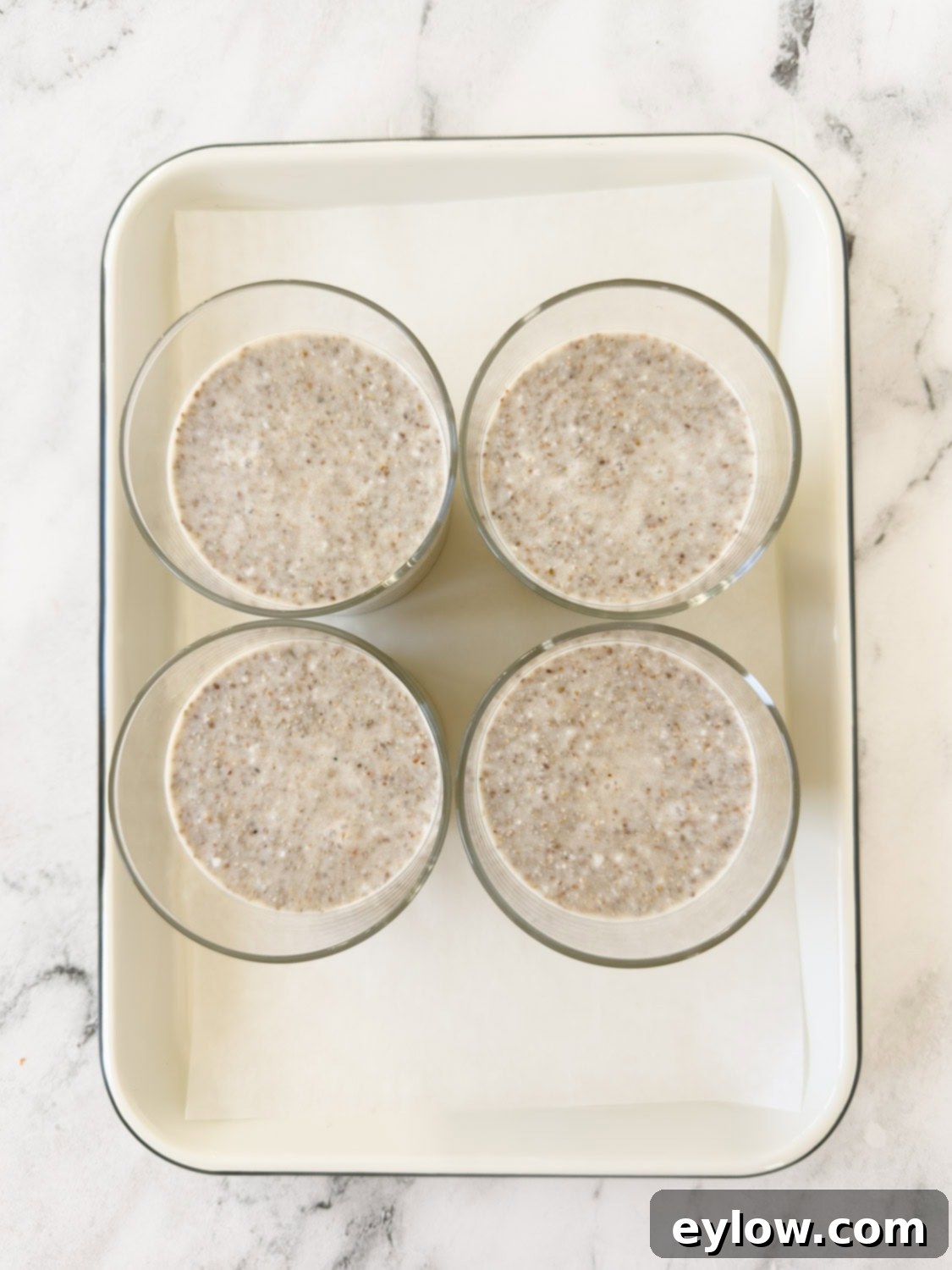
- Portion and Chill: Once everything is combined, carefully pour the liquid chia pudding mixture into four individual containers or glasses. These should ideally be airtight if you plan to store them. Place the containers in the refrigerator and allow the pudding to chill overnight. This crucial step gives the chia seeds ample time to hydrate and swell, transforming the liquid into a wonderfully thick, creamy pudding consistency.
Chef’s Note: The Power of Protein in Your Pudding: While chia pudding is already an incredibly nutritious choice, packed with beneficial fiber and healthy fats, it’s naturally lower in protein. Incorporating protein—whether through protein powder, collagen peptides, or even Greek yogurt as a topping—significantly enhances its satiating power. This boost helps to keep you feeling fuller for a longer duration, stabilizes blood sugar levels, and ensures a more balanced macronutrient profile for your breakfast. It’s a simple yet effective strategy to make this healthy breakfast work even harder for your energy levels and overall well-being throughout the day.
Creative Serving Suggestions for Your Chia Pudding
One of the joys of making chia pudding with coconut milk is its versatility in serving. While it’s most commonly enjoyed chilled, you can also gently warm it for a comforting, porridge-like experience during cooler months. Here are some delightful ways to serve your homemade pudding:
- Fresh Seasonal Fruit: This is a classic for a reason! Top your pudding with a colorful array of fresh seasonal fruits. Think succulent berries (strawberries, blueberries, raspberries), juicy peaches, sweet pomegranate seeds, or sliced kiwi. The natural sweetness and vibrant acidity of the fruit perfectly complement the creamy pudding.
- Homemade Blueberry Compote: Elevate your pudding with a spoonful of my easy blueberry compote. It’s a naturally sweet, antioxidant-rich topping that adds depth of flavor and a lovely texture contrast. You can easily make a batch ahead and keep it in the fridge.
- Banana and Maple Syrup: For a simple yet comforting combination, top with freshly sliced banana and a drizzle of pure maple syrup. The caramel notes of the maple syrup and the creamy banana create a truly satisfying and familiar flavor profile.
- Chopped Nuts or Seeds: Add a delightful crunch and extra healthy fats by sprinkling chopped nuts (like almonds, walnuts, pecans, or cashews) or seeds (such as pumpkin seeds or sunflower seeds) over your pudding. This also contributes to increased satiety, keeping you fuller for longer.
- Nut Butters & Granola: A generous spoonful of almond butter, peanut butter, or cashew butter swirled into the top adds rich flavor and an extra protein kick. For an even more textural experience, add a sprinkle of your favorite granola.
- Cacao Nibs or Dark Chocolate: For a guilt-free indulgence, sprinkle some raw cacao nibs for a bitter chocolate crunch, or a few shavings of high-quality dark chocolate.
Don’t hesitate to customize it daily to fit your mood, energy levels, or what fresh produce is in season – this adaptability truly is one of the best aspects of enjoying chia pudding with coconut milk!
Storage Tips for Chia Seed Pudding
One of the greatest advantages of chia pudding is its excellent make-ahead capability, making it a perfect solution for busy schedules. Proper storage ensures you can enjoy your delicious breakfast or snack throughout the week:
- Refrigeration: For optimal freshness and texture, store your prepared chia pudding in individual airtight containers in the refrigerator. It will keep beautifully for up to 4 to 5 days. Before serving, give it a gentle stir, as the pudding can naturally thicken or settle slightly as it sits. If it becomes too thick for your liking, a splash of additional almond milk or coconut milk will easily bring it back to your desired consistency.
- Freezing (With Caution): While technically possible, freezing chia pudding isn’t always recommended for the best texture. Due to the high fat content in coconut milk, the pudding can sometimes separate or become slightly icy and watery once thawed. If you choose to freeze it, you can store it for up to a month in freezer-safe containers. However, for the most delightful texture and flavor, I highly advise making it fresh every few days. Given how quick and easy it is to prepare, and its impressive shelf life of 4-5 days in the fridge, making it fresh is usually the preferred method.
Recipe FAQs About Creamy Coconut Chia Pudding
Yes, you absolutely can use light coconut milk if you prefer a lower-calorie option. However, be aware that the pudding’s texture will be noticeably thinner and less rich compared to using full-fat coconut milk. To help compensate for the reduced thickness, you might want to consider using a little less liquid overall or adding an extra half-tablespoon of chia seeds to help it set more firmly. Experiment to find your preferred balance!
Several factors can contribute to chia pudding not thickening. The type and brand of milk used can play a role, as some milks (especially thinner, strained varieties) may require more chia seeds. Additionally, older chia seeds might have reduced gelling power. To fix a runny pudding, simply stir in an extra tablespoon of chia seeds per serving and return it to the refrigerator to chill overnight. For future batches, ensure your chia seeds are fresh and consider slightly increasing the chia-to-liquid ratio.
Adding protein is a fantastic way to make your chia pudding more filling and nutritionally complete. The easiest methods include stirring in half a scoop of your favorite protein powder (whey, plant-based, or collagen peptides) directly into the mixture before chilling. Alternatively, you can top your finished pudding with a dollop of Greek yogurt or a sprinkle of hemp hearts. This makes it a perfectly balanced and sustaining breakfast, especially for make-ahead meals.
Absolutely! While chia and coconut pudding is traditionally served chilled, it’s also wonderfully comforting when gently warmed. For a cozy, porridge-like breakfast, especially on a cold morning, simply warm your portion in the microwave on a lower power setting for about a minute, stirring halfway through. Be careful not to overheat it.
Yes, you can certainly use black chia seeds! Both black and white chia seeds are nutritionally identical and will perform the same way in terms of thickening the pudding. The only difference is aesthetic; white chia seeds tend to create a lighter, more uniform-looking pudding, which some people prefer. Use whichever type you have on hand or prefer the look of.
More Delicious Breakfast Recipe Ideas to Explore
If you’re looking for further inspiration to elevate your morning meals, our extensive breakfast index page offers a wide array of delightful recipes, ranging from fluffy pancakes and crispy waffles to invigorating smoothies and gourmet avocado toast. Discover your next favorite breakfast today!
- Gluten-Free Dutch Baby (German Pancakes)
- Gluten Free Breakfast Casserole Recipe
- How to Make Greek Yogurt Parfaits
- High Protein Overnight Oats (with Chia Seeds)
Did You Make This Recipe?
We’d love to hear from you! If you’ve tried our creamy coconut milk chia pudding recipe, please take a moment to add your comment below and let us know what you thought. Your feedback is incredibly valuable and helps other readers. If you absolutely loved it, please consider giving it a 5-star rating! It makes a huge difference in helping more people discover and enjoy this delicious and healthy breakfast.
📖 Recipe Card: Creamy Coconut Milk Chia Pudding
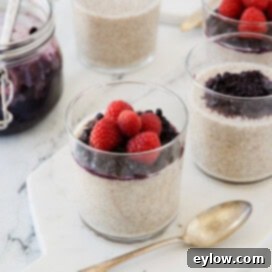
Chia and Coconut Milk Pudding
Author: Sally Cameron
This creamy chia pudding, made with rich coconut milk, offers an incredibly easy and healthy make-ahead breakfast solution. It’s naturally gluten-free and dairy-free, perfectly adaptable with your favorite toppings, and can be customized to suit various dietary needs. For those conscious of sugar intake, using a no-sugar honey or sugar-free maple syrup alternative works beautifully.
Prep Time: 10 mins
Set Up Time in Refrigerator: 8 hrs
Total Time: 8 hrs 10 mins
Course: Breakfast
Cuisine: American
Servings: 4
Calories: 116 kcal (per serving)
Equipment
- Blender (for the smoothest consistency) or a whisk and bowl
Ingredients
- ½ cup unsweetened almond milk
- ¼ cup canned full-fat coconut milk
- 1 ½ tablespoon protein powder (optional, but recommended for satiety)
- 3 tablespoons white chia seeds
- 2 teaspoons honey or sugar-free honey (or maple syrup, monk fruit, to taste)
- ½ teaspoon vanilla extract (or almond extract for a different flavor)
- 1 pinch sea salt
Optional Enhancements
- ⅛ teaspoon cinnamon or other warm spice (like cardamom or ginger)
Instructions
- Prepare the Liquid Base: Add the unsweetened almond milk and canned coconut milk to your blender. If using, add the protein powder at this stage. Blend briefly on low speed until the mixture is completely smooth and homogeneous. If you’re not using a blender, whisk these ingredients thoroughly in a bowl.
- Incorporate Remaining Ingredients: Add the chia seeds, your chosen sweetener (honey, maple syrup, or sugar-free alternative), pure vanilla extract, and a pinch of sea salt to the liquid base. Blend again briefly on low until all the ingredients are just combined and the chia seeds are evenly distributed. If whisking by hand, ensure everything is thoroughly mixed to prevent clumps.
- Portion and Chill: Carefully pour the prepared chia pudding mixture into 4 individual jars, glasses, or airtight containers. Place them in the refrigerator and allow them to chill overnight, or for a minimum of 4-6 hours, until the chia seeds have fully absorbed the liquid and the pudding has set to a thick, creamy consistency.
- Serve and Enjoy: Serve your chia pudding chilled straight from the fridge. For a comforting twist, you can gently warm it in the microwave on a lower power setting for about a minute. Top with your favorite fresh fruits, nuts, seeds, or a drizzle of extra sweetener as desired.
Notes & Customization Tips
- Milk Options: Feel free to swap the almond milk for oat, cashew, flax, or hemp milk. Always choose unsweetened varieties for better control over the sugar content. Remember that the natural viscosity of different milks can affect the final thickness of your pudding. If it’s too thin, add more chia; if too thick, add a splash of milk.
- Flavor Boosters: Get creative with spices! Stir in cinnamon, cardamom, ginger, cocoa powder, or even a hint of espresso powder to completely change the flavor profile.
- Sweetener Choices: Beyond honey and maple syrup, you can use date syrup, agave nectar, or various sugar-free alternatives like monk fruit or allulose. Start with a smaller amount and adjust to your personal taste preference.
- Protein Options: To boost the protein content, besides protein powder, consider collagen peptides or even a dollop of Greek yogurt as a topping. Choose naturally flavored powders to complement your pudding.
- Tree Nut Allergies: If you have tree nut allergies, simply skip the almond milk and opt for oat, flax, or hemp milk as your non-dairy base.
Nutrition Information (per serving, estimates)
Calories: 116 kcal
Carbohydrates: 8g
Protein: 6g
Fat: 7g
Saturated Fat: 4g
Polyunsaturated Fat: 2g
Monounsaturated Fat: 1g
Trans Fat: 0.01g
Cholesterol: 9mg
Sodium: 62mg
Potassium: 94mg
Fiber: 4g
Sugar: 4g
Vitamin A: 19IU
Vitamin C: 1mg
Calcium: 114mg
Iron: 1mg
Nutrition values are estimates based on standard ingredient calculations. Actual values may vary.
Let us know how it was with a comment and leave a star rating!
